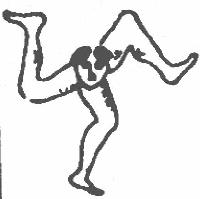
The triskele, sometimes written triskelion, called triquêtre in French, is an interesting symbol. It consists of three legs united at the thigh. It was the symbol of Trinacria (Sicily, thus named for its triangular shape) in the Antique world, and was resurrected by Murat when he became King of Naples in 1808 and gave the kingdom new arms. (The descendants still use those arms). Usually a human face is placed at the conjunction of the thighs.

The symbol also appears in the arms of the Isle of Man, with this difference that, while both symbols consist of three legs embowed, conjoined at the thighs, that of Man is in armour, spurred and garnished or, while the Sicilian legs are naked, and (in some versions) conjoined with a human face.

The symbol also appears in the seal of the United States Department of Transportation (49 CFR 3.1): " The official seal of the Department of Transportation is described as follows: A white abstract triskelion figure signifying motion appears within a circular blue field. The figure is symmetrical. The three branches of the figure curve outward in a counter-clockwise direction, each tapering almost to a point at the edge of the field."